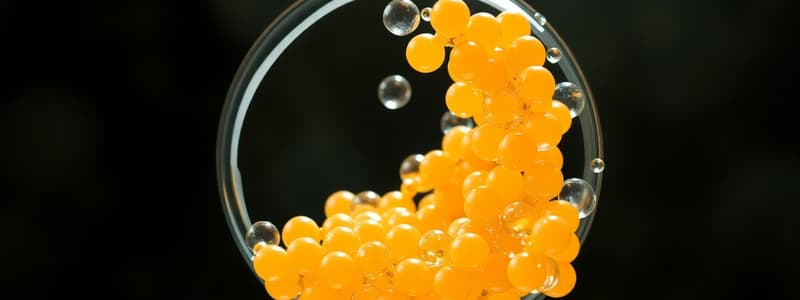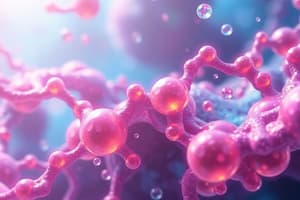Podcast
Questions and Answers
How many Acetyl CoA are produced from the complete β-oxidation of palmitic acid?
How many Acetyl CoA are produced from the complete β-oxidation of palmitic acid?
- 8 (correct)
- 10
- 9
- 7
During β-oxidation of fatty acids, each cycle produces 1 NADH and 1 FADH2.
During β-oxidation of fatty acids, each cycle produces 1 NADH and 1 FADH2.
True (A)
What is the primary energy yield in ATP from the oxidation of palmitic acid?
What is the primary energy yield in ATP from the oxidation of palmitic acid?
129 ATP
In the synthesis of fatty acids, Acetyl CoA and _____ are used as starting materials.
In the synthesis of fatty acids, Acetyl CoA and _____ are used as starting materials.
Match the following fatty acids with their corresponding products of β-oxidation:
Match the following fatty acids with their corresponding products of β-oxidation:
What structural feature distinguishes lipids from carbohydrates?
What structural feature distinguishes lipids from carbohydrates?
Lipids are primarily used for short-term energy storage.
Lipids are primarily used for short-term energy storage.
Name one role of lipids in the human body.
Name one role of lipids in the human body.
Triacylglycerol consists of three fatty acids and one molecule of __________.
Triacylglycerol consists of three fatty acids and one molecule of __________.
Match the type of fat with its description:
Match the type of fat with its description:
Which statement best describes eicosanoids?
Which statement best describes eicosanoids?
Fatty acid catabolism occurs through a process called beta oxidation.
Fatty acid catabolism occurs through a process called beta oxidation.
What is the primary component of membranes formed from lipids?
What is the primary component of membranes formed from lipids?
What is the main component backbone of sphingophospholipids?
What is the main component backbone of sphingophospholipids?
Chylomicrons are limited to transport only free fatty acids in the lymph system.
Chylomicrons are limited to transport only free fatty acids in the lymph system.
What are the two main types of lipids that bile salts help digest?
What are the two main types of lipids that bile salts help digest?
During fatty acid oxidation, _____ is added to the fatty acid structure to activate it.
During fatty acid oxidation, _____ is added to the fatty acid structure to activate it.
Match the types of lipoproteins with their primary functions:
Match the types of lipoproteins with their primary functions:
Which of the following vitamins are fat-soluble vitamins?
Which of the following vitamins are fat-soluble vitamins?
When fatty acids have an odd number of carbon atoms, they yield only Acetyl-CoA during catabolism.
When fatty acids have an odd number of carbon atoms, they yield only Acetyl-CoA during catabolism.
What role do bile salts play in lipid digestion?
What role do bile salts play in lipid digestion?
Flashcards
β-oxidation
β-oxidation
A repetitive process that breaks down fatty acids into two-carbon units (acetyl-CoA), generating NADH and FADH2 in each cycle.
Fatty Acid Activation
Fatty Acid Activation
The initial step in fatty acid oxidation where the fatty acid is activated by attaching it to coenzyme A (CoA), requiring energy (ATP).
Succinyl CoA
Succinyl CoA
A four-carbon molecule produced by the breakdown of propionyl-CoA, which is formed from odd-numbered fatty acids during β-oxidation.
Fatty Acid Synthesis
Fatty Acid Synthesis
Signup and view all the flashcards
Acetyl CoA Transport
Acetyl CoA Transport
Signup and view all the flashcards
Sphingophospholipids
Sphingophospholipids
Signup and view all the flashcards
Glycolipids
Glycolipids
Signup and view all the flashcards
Steroids
Steroids
Signup and view all the flashcards
Steroid Hormones
Steroid Hormones
Signup and view all the flashcards
Lipid Digestion
Lipid Digestion
Signup and view all the flashcards
Lipid Absorption
Lipid Absorption
Signup and view all the flashcards
Lipoproteins
Lipoproteins
Signup and view all the flashcards
Fatty Acid Oxidation
Fatty Acid Oxidation
Signup and view all the flashcards
What are lipids?
What are lipids?
Signup and view all the flashcards
What are the roles of Lipids in the body?
What are the roles of Lipids in the body?
Signup and view all the flashcards
Define fatty acids.
Define fatty acids.
Signup and view all the flashcards
Explain the role of glycerol.
Explain the role of glycerol.
Signup and view all the flashcards
Define Triacylglycerols (triglycerides).
Define Triacylglycerols (triglycerides).
Signup and view all the flashcards
What is a Phospholipid?
What is a Phospholipid?
Signup and view all the flashcards
Define Steroids.
Define Steroids.
Signup and view all the flashcards
Define Lipoproteins.
Define Lipoproteins.
Signup and view all the flashcards
Study Notes
Lipids Overview
- Lipids are defined as water-insoluble (hydrophobic) molecules highly soluble in organic solvents.
- Lipids have both polar and non-polar parts.
- They play crucial roles in energy storage, membrane structure, and signaling.
- Different types of lipids exist, including fatty acids, triacylglycerols, phospholipids, sphingolipids, waxes, steroids, and terpenes.
- Not all lipids have the same structure and properties.
Learning Objectives
- Explain the structural characteristics of lipids.
- Understand the functions of lipids.
- Classify various types of lipids.
- Recognize different fatty acids.
- Explain the processes of lipid digestion and absorption.
- Identify and classify steroids.
- Classify lipoproteins.
- Understand fatty acid catabolism (beta-oxidation).
- Explain fatty acid synthesis.
Types of Lipids
- Fatty acids: Building blocks of many lipids.
- Waxes: Protective coatings.
- Steroids: Include hormones and cholesterol, crucial for cellular functions.
- Phospholipids: Form cell membranes due to their amphipathic nature.
- Sphingolipids: Constituents of cellular membranes.
- Ceramides: Found in cell membranes.
- Triacylglycerols: Important energy storage molecules.
- Eicosanoids: Important signaling molecules derived from arachidonic acid.
- Terpenes: Derived from isoprene units, vital components in certain plant essential oils, pigments, and rubber.
Roles of Lipids
- Energy storage: Lipids store more energy per gram than carbohydrates or proteins.
- Structural components: Lipids are essential components of cell membranes.
- Signaling molecules: Lipids such as hormones regulate various bodily functions.
- Insulation: Lipids provide thermal insulation against cold temperatures.
Lipid Digestion
- Lipids are digested in the mouth, stomach, and intestines.
- Enzymes such as lingual lipase and pancreatic lipase break down lipids into smaller components.
- Bile salts aid in the emulsification of fats, increasing the surface area for lipase action.
- Digestion breaks down triglycerides into monoglycerides and fatty acids.
Lipid Absorption
- Free fatty acids, monoglycerides, and other lipid digestion products are absorbed into intestinal cells.
- These components then reassemble into triglycerides inside the intestinal cells.
- Cholesterol and fat-soluble vitamins are also absorbed.
- Bile salts aid in the absorption of fats.
Lipid Transport
- Absorbed lipids are packaged into lipoprotein particles called chylomicrons.
- Chylomicrons transport lipids from the intestines to other parts of the body via the lymphatic system and the blood.
- Various types of lipoproteins (e.g., VLDL, LDL, HDL) carry different lipid components to different locations.
Lipoprotein Structure
- Lipoproteins have an outer coat of proteins, phospholipids, and cholesterol (unesterified).
- Inner core contains triglycerides and cholesterol esters.
- Different lipoprotein types vary in size, density, and lipid composition, which greatly influences their roles and functions.
Lipid Catabolism (Fatty Acid Oxidation)
- Fatty acids are activated and transported into the mitochondria.
- Beta-oxidation breaks down fatty acids into two-carbon units of acetyl CoA.
- The acetyl CoA enters the citric acid cycle (TCA cycle) to produce ATP.
- Odd-numbered fatty acids yield a propionyl CoA molecule in addition to acetyl CoA.
Fatty Acid Synthesis
- Fatty acids are synthesized in the cytosol.
- The process involves the use of acetyl CoA and NADPH.
- Three main stages are involved: acetyl CoA transport, malonyl CoA synthesis, and elongation of the fatty acid chain.
- The enzyme acetyl-CoA carboxylase is crucial in malonyl CoA synthesis.
- Essential fatty acids (such as linoleic acid and linolenic acid) cannot be synthesized in the body.
Studying That Suits You
Use AI to generate personalized quizzes and flashcards to suit your learning preferences.




